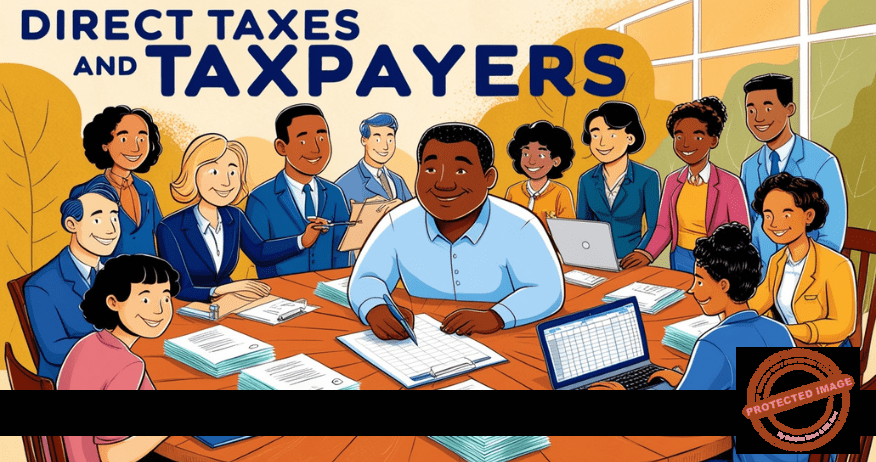In most countries, taxes are collected from taxpayers using two methods: either direct or indirect taxes. The most common methods of tax collection are direct and indirect methods. The incidence of tax is about who endures the tax burden, while the impact of the tax is about who the tax is imposed on.
In some taxes, incidence and impact are borne by the same person, while in other taxes, the impact and incidences are borne by different people.
What is a direct tax?
In direct tax, incidence and impact are on the same person. The tax is imposed on one person, and the person pays the tax. Hence, the tax is demanded from the person it is imposed on. Therefore, the tax burden cannot be transferred to another person.
For example, in Kenya, there is a tax on rental income. The landlord collects the rental income, calculates the tax, and pays the rental income tax directly to the government. Hence, the person the tax is imposed on pays the tax. The person pays the tax directly to the government.
However, there are cases where agents are appointed by the government. For example, employers are government agents for collecting tax on employment income (PAYE). The employers remit the PAYE directly to the government on behalf of the employees.
Examples of direct taxes
In every country, different direct taxes are imposed on the taxpayers by the governments. The taxes are imposed on various income-generating activities, such as employment and business. The taxpayer pays the taxes depending on the activities that they engage in.
The following are some examples of direct taxes that a government may impose on various activities in the country:
- Corporate income tax – where a person earns an income from operating a business.
- Personal income tax – where an individual earns an income other than from employment income and does not have a corporate business.
- Employment income – where a person earns income from employment activities.
- Capital gains tax – where a person gains an income on property transfer.
- Rental income tax – where a person earns an income from renting commercial or residential properties, land, or securities.
- Property tax – tax paid by a person who owns a property in a certain locality.
- Gift taxes – a tax paid by a person for receiving a gift.
What are the advantages of direct taxes to the taxpayers?
Direct taxes have advantages for taxpayers. The advantages can be categorized into two:
a) The fact that the taxpayer is paying direct tax.
b) Other activities involved in paying direct taxes.
However, the advantages of direct tax depend on the taxpayer’s activities. The following are some advantages of direct taxes to the taxpayers.
a. Positive impact on equitable distribution of wealth
Under direct taxes, wealthy taxpayers are expected to pay more tax. Hence, taxpayers, especially low-income earners, are happy to know that wealthy taxpayers pay more taxes. The taxpayers see a fair distribution of the country’s resources.
The extra taxes from the wealthy taxpayers are used to provide specific services that benefit mostly the low-income earners, such as free medical services and education. The income of the wealthy is created mostly by low-income earners. No one can become rich without the contribution of the low-income earners.
For example, manual workers on a plantation may earn a low income, which is a small percentage of the income generated by the plantation owner. The income earned may not be enough to cater to their children’s school fees and medical services.
However, the government ensures that the plantation owners do not retain all the income generated as profits. Part of the income is remitted to the government as taxes for providing social services, such as education and medical services. This enables the fair distribution of wealth in the country.
b. Tax certainty
To the taxpayer, direct taxes have the advantage of certainty. The certainty is in terms of the time to pay the tax, the manner of tax payment, and the amount of taxes to pay. This certainty enables the taxpayer to plan adequately. For example, in Kenya, every employee knows PAYE is payable for all employment income earned every month.
Besides, the employees know the amount of PAYE due to them each month based on their salaries, wages, and any other compensation they get from the employer.
Further, the employees also know that PAYE must be remitted to the government by the 9th day of the next month, even though the employers are responsible for remitting the tax.
Therefore, there is certainty in the payment of direct taxes. The taxpayer knows how much tax they will pay, when to remit the tax, how to remit it, and where to remit it. This is an advantage to the taxpayers.
c. Simple application
The application of some types of direct taxes is simple and easy. Most of the direct taxes are levied on simple flat tax rates. Besides, some taxes are not remitted monthly, but periodically.
For example, Turnover Tax (TOT) is at a flat rate of 3 percent on the monthly gross turnover in Kenya. The tax is reported and remitted quarterly (three-month period) starting from January.
Those taxpayers registered under the TOT system are aware that after every three months, 3 percent of their gross sales for the three months is TOT to be remitted to the government.
Another example of a simplified tax rate is for taxpayers with under kshs 10 million in annual rental income. They pay tax at the flat rate of 10 percent on the gross rental income per month. However, the tax is payable monthly. Therefore, some direct taxes have the advantage of being simple and easy for the taxpayer.
d. Creates public awareness
Direct taxes create public awareness among those who pay the government tax. This awareness is created because the taxpayer pays the tax directly to the government and not through third parties.
Therefore, the taxpayer becomes more interested in the activities of the government, especially in how the tax revenue is used. Hence, the taxpayers demand more accountability from the government on tax revenue expenditure.
This enables the taxpayers to determine whether the government uses the tax revenue to benefit the public. The taxpayers have the confidence to ask questions about how their tax money is used by the government.
The awareness created by direct tax payment makes taxpayers more participatory in tax matters and the country’s affairs. The taxpayers can put the government to using the tax revenue.
What are the disadvantages of direct taxes to the taxpayer?
Direct taxes have disadvantages for taxpayers. The following are some disadvantages of direct taxes to the taxpayers.
a. Direct pain
Taxpayers pay taxes directly to the government from their incomes, salaries, allowances, etc. Though the taxes are desirable, most taxpayers are pained when paying direct taxes. The taxpayers deduct a certain percentage of their earnings and remit it to the government as a direct tax.
The taxpayers know they are making the tax payment, unlike indirect taxes such as consumption taxes (e.g., VAT), where most taxpayers are unaware that they are making any tax payments.
The taxpayers are pained when making direct taxes; they would rather keep the money than give a share of it to the government. The taxpayers experience direct pain from paying direct taxes. This is a disadvantage to the taxpayer.
b. Complex procedures
Sometimes, in complying with the requirements of direct taxes, there are complex formalities in the procedures relating to the source of the income. This is because taxpayers have various sources of income. The majority of taxpayers participate in diverse income-generating activities to ensure their financial stability.
There may also be complexities in the expenditures incurred in generating the income. These complexities are created because various expenses are incurred in generating income.
However, not all expenses incurred in the generation of income are tax deductible. The complexities are experienced where the tax authorities have not developed a simplified tax system targeted for use by the low-income groups in society.
Hence, taxpayers, among them traders, businesspersons, and producers, must conform to many set procedures, which sometimes are complex and require the taxpayer to seek expert advice from tax consultants, tax lawyers, tax auditors, and tax accountants. This, besides, is expensive for the taxpayer and thus disadvantageous.
c. Arbitrary tax rates and interpretation
The tax authorities set the tax rates for direct taxes. The tax authorities can determine the tax rates with no reference to anyone. Besides, the tax authorities set tax laws that guide the implementation of the same direct taxes in the country.
Interpreting the tax laws that guide the implementation of direct taxes is left to the same tax authority. This is a disadvantage to the taxpayer since they have little say in setting up the tax rates and interpreting the tax laws.
d. Requires money to pay
When direct taxes are due to be paid, they must be paid. Otherwise, the taxpayers will pay fines, penalties, and interests. Direct taxes are paid after the person has earned the income, not in the process of earning the income. Sometimes, the taxpayers use the income earned for other more pressing needs, especially business income.
f. Cannot be avoided
It is almost impossible to avoid direct taxes because the activities that the governments impose taxes on are necessary. For example, employment and business activities are necessary activities for survival. Thus, people cannot avoid taxes.
However, with indirect taxes (e.g., consumption taxes), a person can decide not to pay the taxes. They need not consume products that attract taxes. For example, one can decide not to drink soda, which attracts VAT, and drink water from the tap.
g. Inconvenient
Direct taxes are inconvenient for the taxpayer. Taxpayers must ensure that they track all their sales. Besides, the taxpayers must ensure that they have captured all business expenses. The expenses must have a direct relation with the income generated.
Further, the taxpayers must collect the money to pay the taxes when due. This is inconvenient to the taxpayer and, hence, disadvantageous.
Most times, taxpayers do not have a choice about the direct tax systems that the governments impose. However, taxpayers can seek amendments to the tax laws to make direct taxes easier to comply with.
Remember to:
Click HERE to access the e-store page for e-books




